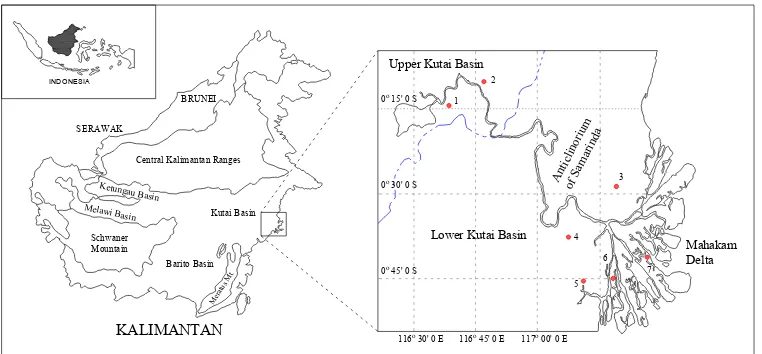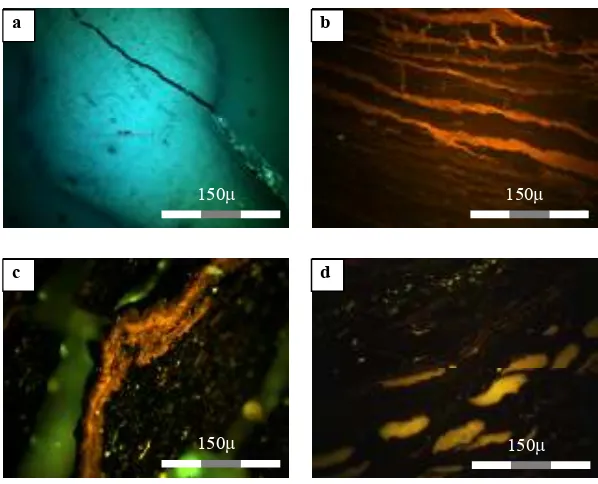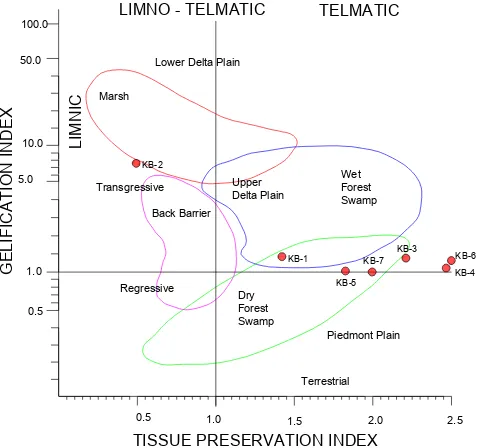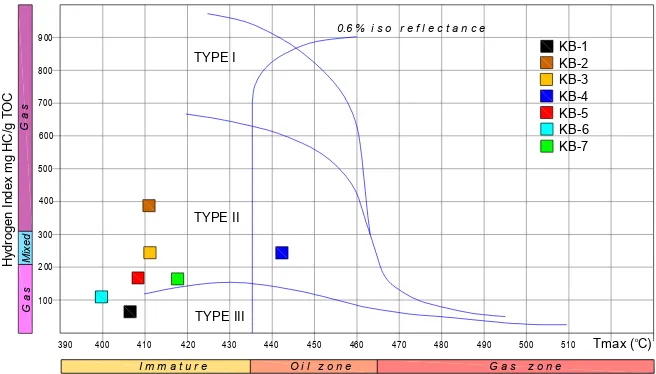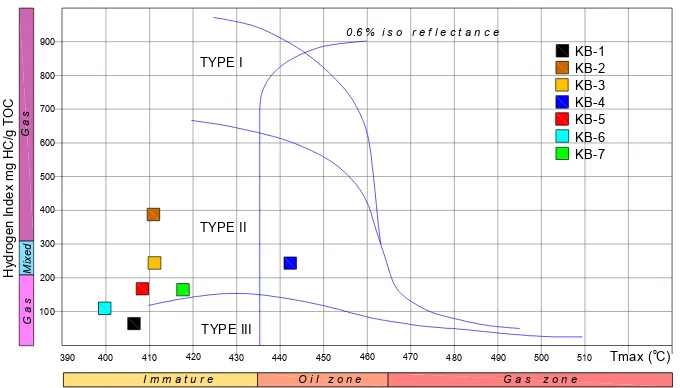Corresponding author: [email protected]
!" #
The present study describes the relationship between macerals constituent, chemical properties and hydrocarbon potential in some Tertiary coals from Lower and Upper Kutai Basin, East Kalimantan, Indonesia. Seven representative coal samples have analyzed from different depositional environments and maturities. They have analyzed by macroscopy, microscopy, chemical properties, total organic carbon (TOC) and Rock1Eval pyrolysis to determine the hydrocarbon potential and depositional environments. Evidence shows that coals have both of gas and oil generation potential. Experiment’s result indicate that coals from Upper and Lower Kutai Basin could have contributed to oil or gas accumulation. Keywords:
!
$
Many previous investigation in Kutai Basin have described the characteristic, type, morphology, genesis based on macerals constituent to predict the paleoenvironmental conditions during deposition of the coals (Anggayana, 1996; Belkin et al., 2009; Widodo et al., 2009; Dwiantoro et al., 2012). It has been knowing that coals could be also as a source rock both of oil or gases. Many publications gave a thorough review of oil1prone macerals, determination of petroleum potential, oil generation, and expulsion potential of humic coal (Peters and Cassa, 1994; Wilkins and George, 2002). Coals may contain significant quantities of the hydrogen1rich and hydrogen generating maceral group such as liptinite, and when heated coals produce petroleum1like pyrolysis product (Tissot and Welet, 1984; Taylor et al., 1998). Early opinion indicated that the vitrinite source of was gas1prone, liptinite was oil1prone, and inertinite had little or no petroleum generation potential (Tissot and Welte, 1984).
The aim of this study are using organic petrography and geochemistry properties to evaluate their optical properties correspond with the hydrocarbon potential based on some coals from different maturities and depositional environments.
%$ & & &
Schwaner different maturities and depositional environments. The geological setting shows that basin acumulated and inverted in the middle of Miocene and created a great amount of anticline traps, named Samarinda Anticlinorium, that provide the prolific hydrocarbon production in the basin (Clay et al., 2000; Moss and Chamber, 1999).
'$
'$ () * + , )- "-"
The geology field investigation and petrographic were carried out to achieve the aim of the study. Coal samples were collected from two depositional setting that were from Upper Kutai Basin (KB11 and KB12) and Lower Kutai Basin (KB1 3, KB14, KB15, KB16, and KB17). Three coal samples were collected from shallow drill holes activities that were KB12, KB16, KB17 and the others came from four coals outcrop (Figure 1). Each coal samples were determined in lithotype appearances in term of brightness versus dullnes. Lithotypes are macrocopically recognisable band of coals sample. Describing lithotype sequences, 1 cm was chosen as the minimum thickness for the delineation of individual lithotypes. The macroscopic analysis can predict the microscopic constituent of coals. A lithotype log form can also useful basis for sampling and describing vertical variation in seam relative both of macroscopic and microscopic properties. Beside that, it could be a basis for an interpretation of the succesion of mire conditions during the seam formation.
'$% - * ), # "-"
The samples were crushed under 1 mm grain size and particulate pellets excluding fines were prepared by cold embedding in epoxy resin. Quantitative assesment of macerals, their description and reflectance measurements (Rv) were carried out following ICCP 1994. Vitrinite reflectance measurement is a standard and very accurate to determine the rank of bituminous coals. The determination of reflectance vitrinite were performed at PSDG Bandung (Center for Geological Resources), 50 points for Rv were measured of each polished block. Yttrium1 alluminium1garnet with reflectance 0,89% and Spinel with reflectance 0,43% were used for a standard for determination of Rv. Oil immersion objectives 50x/0.85 and 100x/0.25 were used also.
Maceral analyses. The petrographic composition was obtained by macerals under standard condition for maceral analyses (ISO 740412009). Point counting was performed on seven polished samples to evaluate the micropetrographic composition. Maceral point counting analyses were perfomed at Mining and Exploration Department1ITB using an Axio Imager A2m reflected light microscope equipped with photometer of white and ultra violet sources (blue light excitation used for recognition and differentiation of liptinite macerals). Also automatic counter “Prior G” was used for the counting of the macerals.
'$' - - . (- "-"$
The lithotype studies combined with micropetrographic analysis have been used to aid in the interpretation of coal depositional environments. The formulas to define the environment deposition are Tissue Preservation Index (TPI) and Gelification Index (GI) according to Diessel (1992) and Kalkreuth et al., (1991). The Kalkreuth’s formula to determine the paleoenvironment of the low coal rank stages, whereas the Diessel’s formula define the sub bituminous and high volatile bituminous stages.
Kalkreuth’s original TPI and GI formula was given as:
textinite+texto ulminte+ulminite+corpohuminite+fusinite TPI = 11111111111111111111111111111111111111111111111111111111111111111111111111 attrinite+densinite+macrinite
textoulminite+ulminite+corpohuminite+densinite+macrinite GI = 11111111111111111111111111111111111111111111111111111111111111111111111111
textinite+attrinite+fusinite+inertodetrinite
Diessel’s’s original TPI and GI formula was given as
vitrinite + macrinite
GI = 111111111111111111111111111111111111111111111111111111111111111 semifusinite + fusinite + inertodetrinite
Tissue preservation index (TPI) is the ratio of tissue1derived structured maceral versus tissue1derived unstructured maceral is a measure not only of the degree of humification suffered by the maceral precursors but to some extent it also gives an indication of the proportion of wood which has contributed to the peatland and was preserved in it. Maximum TPI indicates a balance ratio of plant growth and peat accumulation versus rise in groundwater table, for example due to basin subsidence. A low TPI suggest either a predominance of herbaceous plants in the mire or large1scale destruction of wood because of extensive humification and mineralisation (Diessel, 1992). While, the Gelification index (GI) is the ratio of intensely gelified versus non gelified macerals. The higher of GI values indicate increased moisture in the mire and higher rate of subsidence and also decreased the oxidation.
'$/ &- #,-( # )- -"
Coal samples were also subjected to chemical properties (proximate and ultimate), and organic geochemical studies comprising the following: (a) TOC determinination to estimate the quantity of organic matter in each samples, and (b) Rock1Eval pyrolysis to determine the hydrocarbon generative potential of the organic matter (S1, S2, S3, Tmax, and the derivatives HI and OI). The total organic
carbon (TOC) and Rock1Eval Pyrolysis were performed at LEMIGAS (research and development center for oil and gas technology) Jakarta1Indonesia. The total organic carbon (TOC) content was measured using a carbon deteminator LECO SC1144 DR. Pyrolysis analyses using a Rock1Eval 6 instrument.
/$
/$ # "# ) # , #
-Coals from Upper Kutai Basin have special lithotypes profile dominated by dull (KB11) and banded dull (KB12). The lithotypes variation indicate the range of wet and dry conditions reflecting subsidence rate with fusain representing durain for dull coal and clarain for banded. The dull coal consist of macerals such as inertinite group (funginite, semifusinite and inertodetrinite) and also mineral matter groundmass. It was conclude that these dull lithotype were performed during period of elevated water and circulation within the mire.
/$% # "# ) # "-"
Result from reflectance measurements on the vitrinite maceral, the mean maximum reflectance value of the samples (Rmax, %) reveal that the coals from
Kutai Basin attained various maturities (0.2410.80%). It have reached peat, liginit, and sub bituminous B and C stages. The KB14 has a higher reflectance value than other coal samples, it was influenced by the pressure of anticline trap surrounding the area. Macerals from Huminite Group are prevailing in the study of coals. The amount of those huminite varies from 53.6171.6%, inertinite from 5.8111.2 (%), and liptinite from 11.2111.8 (%) (Figure 2).
Figure 2. Representative photomicrographs macerals from potential source rock
from different environments in Kutai Basin. Scale bar 50 Nm. (a) telocolinte as a source of gas1prone, under reflected white light;
(b,c,d) cutinite, suberinite, and alginite are source of oil1prone, fluoresence light under ultraviolet excitation.
Macerals from Vitrinite Group have amount of vitrinite varies from 35.6 – 53.6% which dominated by telinite and colotelinite. Macerals from Inertinite Group were low to moderate (5.8127.6%) value. Semifusinite, inertodetrinite, funginite were the main macerals of the inertinite group recorded. Macerals from Liptinite Group are moderate value (11.2147.6%). Resinite, suberinite, cutinite, liptodetrinite, alginite were the main macerals of the liptinite group recorded (Table 1 in Appendix 1).
!
# +
150N 150N
/$' - - . (- "-"$
Examination of lithotype variations and the distribution macerals constituent suggested some Tertiary coals as a limnic (marsh depositional setting) and telmatic (wet and dry forest swamp depositional setting) (Figure.3).
Figure 3. Facies diagram and suggested depositional environment for study areas (after Diessel, 1992).
/$/ ,-( # , # - " #
The air dried basis was used to analyze the chemical properties. The Tertiary coals of Kutai Basin shows typical of low rank and sub bituminous coal (Table 2 in Appendix 1). The coals of Upper Kutai Basin KB11 and KB12 have total moisture (13.34133.7%) and ash content (3.7515.04%). Their volatile matter content (41.27142.86%). The amount of low sulphur varies from 0.1810.31% and calorific values (512915529 cal/g) were low with relatively low fixed carbon content (42.42142.77%). The ultimate analysis shows their carbon content varying between 58.17161.29% and hydrogen content varies from 5.1715.27. The oxygen content varies from 27.39131.61%. The coals of Lower Kutai Basin consist of KB13, KB14, KB15, KB16 and KB17. There was a coalfield strongly caking that coal from KB14. It has high calorific value (8308 cal/g), low total moisture content (1.43%), low ash content (1.53%), high content of fixed carbon (58.16%).
The ultimate analyses shows the high carbon (85.18%) content, low sulphur (0.38%) content and both low of hydrogen (5.83%) and oxygen (4.58%) content. The other coals differ distincly by being non1caking in the nature. They have average moderate of total moisture (13.58120.94%) and ash (1.4317.21%), and the amount of sulphur of coals are low content (0.1710.45%). While their volatile matter (41.18143.95%) and calorific values varying from (531916324 cal/g). The
ultimate analyses showed the varying values of elements such as carbon (59.291 68.77%), hydrogen (4.9615.64%) and oxygen (22.35127.28%).
/$0 &- #,-( # * # , # - " #
The Rock1Eval pyrolysis showed the results of coal samples from Upper Kutai Basin (KB11 and KB12) and Lower Kutai Basin (KB13, KB14, KB15, KB16, and KB17). The TOC content of Upper Kutai Basin ranges from 42.69157.39%, while the Lower Kutai Basin varying from 61.80183.12 %. All of the high TOC content
of coals indicated the excellent as source of hydrocarbon potential (Figure. 4). The maximum temperatur (Tmax) data indicates that the coals are characterized by
the value from 4001445oC. Moreover based on Hydrogen Index (HI) organic mattter have varying value from 731260 mgHC/g TOC. Plotting on the Tmax
Figure 5. Plotting on the hydrogen index (HI) versus Tmax diagram, showing
kerogen type and maturity level of coal samples from the research areas (after Peters and Cassa, 1990).
0$
Tertiary coals from Kutai Basin were rich in vitrinite and liptinite. They were the most common macerals in the coals constituting major proportion by volume. The coal rank on the basis of vitrinite reflectance attained various maturities. These coals reached peat, lignite, sub1bituminous B and C stages. The lithotype variation consist of dull, banded, and bright in nature. Examination of lithotype variations and the distribution macerals constituent suggested some Tertiary coals as a limnic (marsh depositional setting) and telmatic (wet and dry forest swamp depositional setting). Based on reflectance measurement and geochemistry analyses in these research area that coals were mainly at an early stage (immature) of oil/gas generation.
-1- - #-"
1. Anggayana K., 1996. Mikroskopische und organisch 1 geochemische untersuchungen an kohlen aus Indonesia, ein beitrag zur genese und fazies verschiedener kohlenbecken, Dissertation RWTH Aachen, Germany.
2. Belkin, H.E., Tewalt, S.J., Hower, J.C., Stucker, J.D., and O’Keefe, J.M.K., 2009. Geochemistry and petrology of selected coal samples from Sumatra, Kalimantan, Sulawesi, and Papua, Indonesia. International Journal of Coal Geology, vol. 77, pp. 2601268.
3. Diessel C.F.K., 1992. Coal bearing depositional system. Springer1Verlag Berlin Heidelberg.
4. Dwiantoro D., Notosiswoyo S., Anggayana K., and Widayat A.H., 2012. Paleoenivormental interpretation based on lithotype and macerals variations
from Ritan’s lignite, Upper Kutai Basin, East Kalimantan, Procedia Earth and Planetary Science, vol. 6, pp. 1551162.
5. Kalkreuth, W.D., Marchioni, D.L., Calder, J.H., Lamberson, M.N., Naylor, R.D., Paul J., 1991. The relationship between coal petrography and depositional environments from selected coal basins in Canada. International Journal of Coal Geology. vol. 19, no.1, pp. 21176.
6. McClay K., Dooley T., Ferguson A., Poblet J., 2000. Tectonic evolution of the Sanga Sanga block, Mahakam Delta, Kalimantan, Indonesia. AAPG Bulletin vol.84, no.6, pp. 7651786
7. Moss, S.J., and Chamber, J.L.C., 1999. Tertiary facies architecture in the Kutai Basin, Kalimantan, Indonesia. Journal of Asian Earth Sciences, vol.17, pp.1571182.
8. Peters K.E., and Cassa, M.R., 1994. Applied source rock geochemistry, in Magoon, L.B., Dow, W.G. (Eds.), The petroleum system: from source to
trap. AAPG Memoir, vol. 60, 931117.
9. Taylor, G.H., Teichmuller, M., Davis, A. Diessel, C.F.K., Littke, R., Robert, P., 1998. Organic Petrology, 1st ed.,Gebruder Borntraeger, Berlin and Stuttgart.
10. Widodo S., Betchel A., Anggayana K., and Puttman W., 2009. Distribution of sulfur and pyrite in coal seams from Kutai Basin (East Kalimantan, Indonesia): Implication for paleoenvironmental conditions. International Journal of Coal Geology, vol.81, no.3, 1511162.
Table 1. The frequency distribution of various macerals from different maturities and environments from Kutai Basin, East Kalimantan, Indonesia.
Te: telinite, Tx: textinite, Crp: corpogelinite, Fg: funginite, Sp: sporinite, ltd: liptodetrinite, Col: colotelinite, Crph: corpohuminite, Vitr : amount of vitrinite, Ma: macrinite, Cu: cutinite, Lipt: amount of liptinite, Vtr: vitrodetrinite, Den: densinite, Fu: fusinite, Idt: inertodetrinite, Sb: suberinite, Mm: mineral matter Cldt: colodetrinite, Atr: attrinite, Sf : semifusinite, Inert: amount of inertinite, Re: resinite, Σ: total of macerals, Rv: reflectance vitrinite, GI: gelification index TPI: tissue preservation index
Table 2. Total organic carbon (TOC), Rock1Eval pyrolysis, proximate and ultimate result of representative coal samples from Kutai Basin, East Kalimantan, Indonesia
' KB11 Muara Batua (UB) 372396E / 3746N Kampungbaru 0+<24 '<*5 1'<)5 1*<2' 0)3 1+<22 31 51 11<3 1<3* 0'<+3 0+<33 *'+4 *5<'3 *<+3 1'<2' )<54 )<1' + KB12 Ritan (UB) 387199E / 37142N Balikpapan *3<14 1<'1 51<'2 +4<+1 0'+ 52<+4 '0* *' '1<'0 *<)0 0+<52 0+<0+ **+4 2'<+4 *<'3 +3<14 )<41 )<'5 1 KB13 Loa Tebu (LB) 504076E / 9960860S Balikpapan 3'<*5 +<'2 '5*<5 1<' 0'+ '53<45 +2) 0 '1<*5 '<01 0'<14 05<10 21+0 25<33 *<05 ++<1* '<*+ )<0* 0 KB14 Ketapang (LB) 468653E / 9957458S P amaluan 51<'+ 1<0' +'*<3 +<30 00* +'4<'* +2) 1 '<01 '<*1 14<+4 *5<'2 5105 5*<'5 *<51 0<*5 +<*) )<15 * KB15 Batuah (LB) 505997E / 9924427S Balikpapan 22<23 '<)+ ''5<* ''<++ 0'4 ''4<*2 '35 '3 +)<40 +<)4 01<4* 00<' 2)'* 2*<' *<20 +*<2* '<1* )<'3 2 KB16 Loa Janan (LB) 514416E / 9924331S Balikpapan 2'<5 +<5* 31<10 12<35 0)) 32<'4 ''4 2) '0<5* 3<+' 0'<'5 0'<53 *1'4 *4<+4 0<42 +3<+5 '<)4 )<'3 3 KB17 Sangasanga (LB) 531571E / 9932656S Kampungbaru 21<*+ +<15 ''0<1 '4<+* 0)4 ''2<22 '5) 1) '*<+2 '1<15 4<1+ 13<4* 14<1* 2+<0' 0<53 +5<0* '<++ )<0+
! ' ( )( % & # $ ")#$ ( " # $
